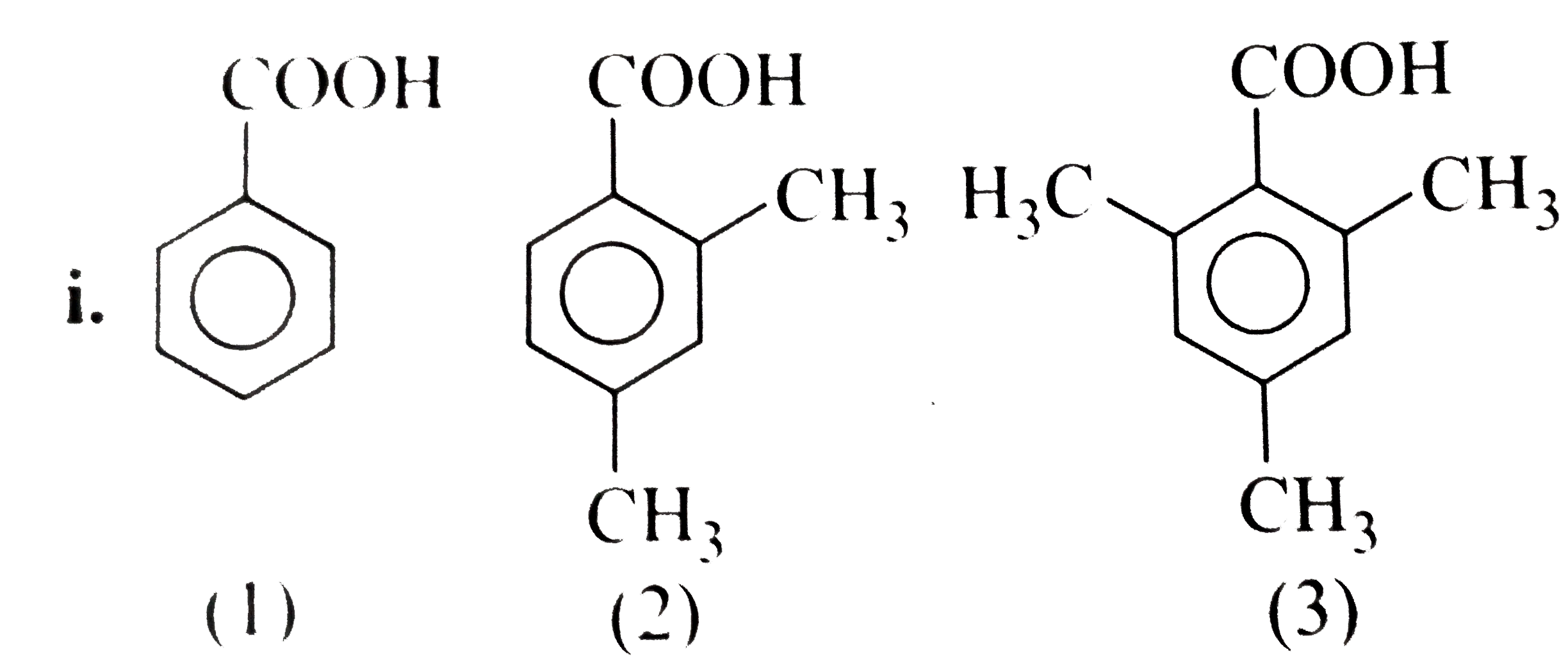Arrange the following monomers in order of decreasing ability of undergo cationic polymerisation.
(I) CH2=CH−C6H4(NO2)
(II) CH2=CH−(C6H4(CH3)
(III) CH2=CH−C6H4(OCH3)
I>II>III
II>I>III
III>II>I
I>III>II
The correct Answer is:C
More stable is carbocation more is ability to undergo cationic polymerisation.
+I and +R nature of −OCR3 stabilizes carbocation.
Topper's Solved these Questions
- BIOMOLECULESBOOK - A2ZCHAPTER - BIOMOLECULESEXERCISE - ASSERTION-REASONING
4 Videos
- BIOMOLECULESBOOK - A2ZCHAPTER - BIOMOLECULESEXERCISE - Chemistry in everyday life
7 Videos
- BIOMOLECULESBOOK - A2ZCHAPTER - BIOMOLECULESEXERCISE - Assertion-Reasoning Questions
9 Videos
- ALDEHYDES, KETONES AND CARBOXYLIC ACIDBOOK - A2ZCHAPTER - ALDEHYDES, KETONES AND CARBOXYLIC ACIDEXERCISE - Section D - Chapter End Test
30 Videos
- CHEMICAL KINETICSBOOK - A2ZCHAPTER - CHEMICAL KINETICSEXERCISE - Section D - Chapter End Test
30 Videos
Similar Questions
Arrange the following in decreasing order of reactivity towards aqueous KOH.
(i). CH2=CH−Cl
(ii). C6H5CH2Cl
(iii). CH2=CH−CH2Cl
(iv). C2H5−Cl
View Solutiona. Acid halides, anhydrides, esters and amides, all of them contain (C=O) group but none of them gives test for (C=O) group, i.e., they do not form oximes, hydrazones, and DNP derivatives, etc. Why?
b. Arrange the following in the decreasing order of nucleophilic addition.
i. (1)−CHO
(2)−COCH3
(3)−COOH
(4)−COCI
(5)−CONH2
(6)−COOCH3
(7)−COOΘ
ii. (1)CH3CHO
(2)CH3COCH3
(3)HCHO
(4)CH2H5CH2COCH3
iii. (1)CH3COCH3
(2)C6H5COCH3
(3)C6H5COC6H5
(4)C6H5CH2COCH3
iv. (1)C6H5CHO
(2)ρ−CH3.C6H4.CHO
(3)ρ−OH.C6H4.CHO
(4)ρ−NO2.C6H4.CHO
(5)ρ−CI.C6H4.CHO
v. (1)HCHO
(2)CH3CHO
(3)CH3COCH3
(4)CI3CCHO
c. Arrange the following in the increasing order of ease of hydrolysis.
(1)CCH3COOC2H5
(2)CH3COCI
(3)(CH3CO)2O
(4)CH3CONH2
d. Arrange the following in the increasing order of ease of acid-catalysed esterification of:
i.
ii. (1)CH3CH2COOH
(2)(CH3)2CHCOOH
(3)(CH3)3CCOOH
iii. (1)CH3CH2CH2OH
(2)CH3CHOHC2H5
(3)(CH3)2C(OH)C2H5
e. Arrange the following esters in decresing order of ease of alkaline hydrolysis.
i. (1)HCOOCH3
(2)CH3COOCH3
(3)(CH3)3CCOOCH3
(4)(CH3)2CHCOOCH3
ii. (1)CH3COOCH3
(2)CH3COOC(CH3)3
(3)CH3COOCH(CH3)2
(4)CH3COOCH2CH3
iii. (1)C6H5COOCH3
(2)ρ−CH3O−C6H4−CCOOCH3
(3)ρ−NO2−C6H4−COOCH3
(4)ρ−Cl−C6H4−COOCH3
View Solution
Knowledge Check
The order of decreasing stability of the carbanions :
(CH3)3C−(I),(CH3)2CH−(II),CH3CH−2(III),C6H5CH−2(IV) isAI>II>III>IVBIV>III>II>ICIV>I>II>IIIDI>II>IV>III.The decreasing order of stability of the carbonium ions
C6H5CH+2(I),p−(CH3O)C6H4CH+2(II)
p−(NO2)C6H4CH+2(III),p−(CH3)C6H4CH+2(IV) isAIV>II>I>IIIBII>IV>III>ICII>IV>I>IIIDIV>II>III>IThe order of decreasing stability of the carbanions (CH3)3C−,(CH3)2CH−(II),CH3CH−2(III),C6H5CH2 (IV) is
AI>II>III>IVBIV>III>II>ICIV>I>II>IIIDI>II>IV>III
Arrange the following compounds in the increasing order of their boiling points:
CH3CH2CH2CHO,CH3CH2CH2CH2OH,H5C2−O−C2H5,CH3CH2CH2CH3
View SolutionArrange the following compounds in the increasing order of their boiling points:
CH3CH2CH2CHO,CH3CH2CH2CH2OH,H5C2−O−C2H5,CH3CH2CH2CH3
View SolutionThe order of decreasing stability of the following carbanions is
(i) (CH3)3C−
(ii) (CH3)2CH−
(iii) CH3CH−2
(iv) C6H5CH−2
View SolutionRank the following free radicals in order of decreasing stability
(I)C6H5CH6H5 (II) C6H5−CH−CH=CH2 (III) CH3−.CH−CH3 (IV) C6H5−.CH−CH3 (V) CH3CH=CHCH2.CH2 (VI) CH3−CH2−.C∣CH3−CH3
View SolutionArrange in order of decreasing reactivity in electrophilic addition:
(I)PhCH=CHCOOH
(II)p−NO2−C6H4−CH=CHCOOH
(III)p−MeOC6H4CH=CHCOOH
(IV)p−C1C6H4CH=CHCOOH
View Solution
